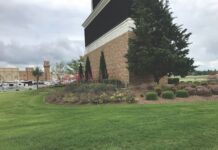You never want to leave money on the table—no matter what type of business you operate. But when arborists or tree care professionals leave the job site without talking to the homeowner or property manager about preventative tree care, that’s exactly what happens. Worse, this also means you’re not leveraging your skills and expertise to help keep people, as well as their pets and property, safe. Here are few preventative services all tree care providers should be offering.
Recommend regular and routine pruning. Regular pruning will not only help keep your clients’ trees vigorous and looking their best, but it’ll help you spot potential red flags long before they cause problems.
For example, your client may not notice that his or her maple tree is starting to display some troubling symptoms of leaf spot. But once you get to the property and set up your gear, it’ll become obvious to you. Alternatively, you may notice an insect issue developing on your client’s ash or citrus trees, which will require immediate action to head off more serious problems. But you can only notice these types of things if you are regularly visiting clients’ properties and getting up close with the trees.

Additionally, by getting your clients to sign up for a regular pruning service, you’ll stay front-and-center in your client’s mind. This means he or she is less likely to go surfing on the web for other tree care providers when they do need services.
Always monitor mushrooms growing near trees. Not all fungi are particularly harmful to trees, but most mushrooms deserve a close look. And whether or not the mushrooms are likely to spell doom for a tree, they represent a significant and legitimate opportunity to offer preventative tree services.
In many cases, you’ll notice that the tree is exhibiting other concerning signs upon closer inspection. And this may lead you to recommend the tree be pruned or removed. Even if the homeowner decides to take a more measured approach, you can likely assist him or her in obtaining a positive ID of the fungus and performing more detailed studies. Most importantly, by preventatively addressing fungal growth, you may help your clients keep their homes and families safer.
Talk to clients about extensive vine growth. In some cases, vines represent little harm to trees, but they can certainly diminish a tree’s vigor or even make it more susceptible to structural failure. Accordingly, it is always wise to take a close look at trees bearing lots of ivy.
Even if the vegetation doesn’t appear to be harming the tree, the client may want it removed for other reasons. Maybe it’s aesthetically unappealing. Maybe they are concerned about it harboring pests, or there is an invasive species they’d like eliminated. You won’t know unless you dig into the issue.
Discuss options for trees with co-dominant stems. Co-dominant stems are never a good sign, but they don’t always necessitate removal. And part of the reason that’s true is that you can offer several services to help fortify the tree to reduce chance of failure.
So, take a moment to look over any significant co-dominant stems growing in your client’s yard. If you think that failure is likely, consider recommending the homeowner have cabling or other types of fortifications installed. If the price tag associated with this gives them pause, compare it with the costs (both in terms of your final bill and the loss of property value) that will be associated with full removal.
So, the next time you’re on the job site, take a few minutes to look for preventative tree services that would benefit your clients. Some will decline the services you suggest, but others will appreciate your offers and agree with your recommendations. And when this happens, you can be sure that you, your client, and their trees will all benefit.
Doherty is senior vice president of specialty programs at NIP Group, a specialty insurance program manager that designs commercial insurance solutions and risk services for more than 25 niche industries. He has over 12 years of experience in the insurance industry, specializing in business development and client growth sectors.
Do you have a comment? Share your thoughts in the Comments section below, or send an e-mail to the Editor at acosgrove@groupc.com.











![[VIDEO] Dickies®: Discover Workwear That’s Anything But Uniform](https://turfmagazine.com/wp-content/uploads/2023/06/1647663814-4b1a2a7742790a9b1e97a3b963477850192e1d6a9dfba9b07214a77bae25d6e3-d-218x150.jpg)






























![[VIDEO] Dickies®: Discover Workwear That’s Anything But Uniform](https://turfmagazine.com/wp-content/uploads/2023/06/1647663814-4b1a2a7742790a9b1e97a3b963477850192e1d6a9dfba9b07214a77bae25d6e3-d-324x160.jpg)